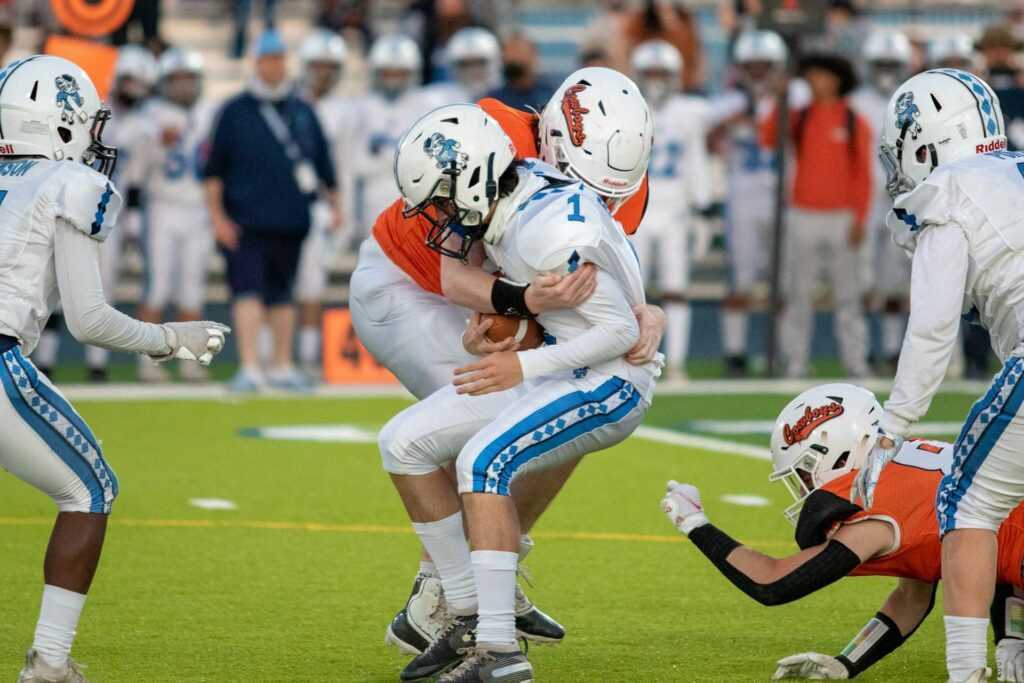The 2025 NFL Draft signals the arrival of a new wave of talent and quickly shifts focus to which rookies might shine in their debut season. Betting markets for Offensive and Defensive Rookie of the Year have opened, offering early insight into expectations. Draft position, team fit, and opportunity remain key indicators of rookie success. Odds from sources like FanDuel highlight favorites, sleepers, and traps—shaping how the draft could impact teams and the league.
With that in mind, let’s dive into how the draft will affect teams – and the league as a whole.
Offensive Rookie of the Year Frontrunners Emerge
The top of the Offensive Rookie of the Year (OROY) odds board, according to the latest figures from FanDuel, is currently populated by a quarterback and a running back, mirroring recent trends in the award’s history.
Cam Ward, selected first overall by the Titans, holds the shortest odds at +330. Close behind is Ashton Jeanty, the Las Vegas Raiders’ sixth overall pick, with odds of +340.
Both players currently lead the race in NFL odds on FanDuel, reflecting early confidence in their usage and scheme fit.
Looking back at history, the award has frequently gone to these positions; since 2010, eight quarterbacks and four running backs have claimed the OROY title.
Ward is anticipated to be a Week 1 starter, benefiting from a clear path to significant snap counts in a modern pass-heavy offense. Jeanty, the earliest-drafted running back since Saquon Barkley in 2018, could see high volume in a run-focused scheme.
Identifying Value in OROY Odds
Beyond the top favorites for the 2025 season, several players present appealing value bets for Offensive Rookie of the Year due to favorable landing spots or skill sets that could lead to high production despite longer odds.
Quinshon Judkins, a running back selected 36th overall by the Cleveland Browns, is listed at +1600 odds and is considered a bet worth evaluating carefully.
Judkins is projected as the lead back, potentially taking on a workload similar to Nick Chubb’s given Chubb’s absence. His athletic profile tested similarly to Chubb’s at the NFL Scouting Combine, with Judkins being slightly faster.
Quinshon Judkins delivered an outstanding college career, forcing 199 missed tackles over three seasons—ranking third among all Football Bowl Subdivision (FBS) running backs during that span. In 2024, he earned a 90.0 grade from PFF (Pro Football Focus), the highest mark among Big Ten running backs, highlighting both his consistency and elite-level performance.
Tight End Tyler Warren and Other Sleepers
Another potential value pick is tight end Tyler Warren of the Indianapolis Colts, who holds +2500 odds for OROY. Selected 14th overall, Warren landed in a situation with a glaring need at tight end, where Mo Alie-Cox had not surpassed 20 catches or 200 receiving yards in the prior three seasons.
Warren is expected to be the clear TE1 and a primary target for the Colts’ quarterback. He excels after the catch, recording 693 yards in 2024, the second most ever by a tight end in the PFF era, a skillset that aligns well with the Colts’ receiving corps needing improvement in YAC (ranked 31st in the NFL last season with 1,521 yards).
Recent success of rookie tight ends like Sam LaPorta and Brock Bowers finishing high in OROY voting makes Warren’s long odds enticing given his opportunity.
Additional Day 2 and 3 offensive prospects like QB Tyler Shough (+2000) and RBs TreVeyon Henderson (+2000), Kaleb Johnson (+5000), and R.J. Harvey (+5000) also landed in spots with potential opportunity.
Navigating Potential OROY Traps
While some players offer value at longer odds, others present themselves as “traps” in the betting market—enticing picks based on talent or name recognition, but with underlying factors that may limit their Rookie of the Year potential.
An example is Travis Hunter, a wide receiver/cornerback selected by the Jacksonville Jaguars, who is listed with favorable odds for OROY (+750), but may not receive the necessary volume on offense.
Despite undeniable talent and elite college production (only 3 drops on 194 career targets), the Jaguars reportedly plan to rely more on him on offense with limited defensive snaps, placing him behind second-year receiver Brian Thomas Jr., potentially hindering his OROY case based on name value alone.
Running Back Omarion Hampton’s Challenging Path
Omarion Hampton, a running back taken 22nd overall by the Los Angeles Chargers, faces significant hurdles despite promising talent and +1400 OROY odds. Hampton demonstrated strong college performance, ranking second among all college football running backs with 2,330 yards after contact over the past two seasons.
However, his path to early-season production is complicated by the Chargers having recently signed Najee Harris and potentially re-signing J.K. Dobbins.
While Hampton could eventually earn a starting role, skepticism exists regarding his immediate opportunities and the volume needed to become an OROY frontrunner (given the existing backfield competition).
Defensive Rookie of the Year Outlook
Predicting the Defensive Rookie of the Year (DROY) is often considered more predictable than OROY, as the award heavily favors early first-round draft picks. Since 2000, a striking 22 out of 25 DROY winners were selected in the first round, with most being taken in the first half of the round.
Abdul Carter, the New York Giants’ third overall pick, leads the early odds at +240. Edge rushers hold a distinct advantage in this race, primarily due to their potential for easily trackable “splash plays” like sacks; five of the last six DROY awards have gone to this position. Other early favorites include Jalon Walker (+550), Mason Graham (+750), and Mykel Williams (+900).
DROY Values, Sleepers, and Traps
While early first-round edge rushers dominate the DROY conversation, value can be found in players with longer odds, though historical trends present challenges for some positions and draft slots.
A prime example is Mike Green, an edge defender selected 59th overall by the Baltimore Ravens. Green is listed at +1500 and is viewed as a potential steal based on talent.
Green was the only edge defender in college football in 2024 to earn PFF grades of 90.0 or higher in both pass rushing and run defense and tallied 17 sacks in his final year. Despite slipping in the draft and potentially rotating initially, his explosiveness could make him look like a steal by mid-season (if he stays healthy).
Historically, however, Day 2 edge rushers face precedent against winning the award based on their draft position. Conversely, Mykel Williams (+900), despite being a first-round pick (11th overall), is considered a trap. Williams graded significantly better as a run stuffer (86.6 PFF run-defense grade) than a pass rusher (mid-70s PFF pass-rush grade) and managed only five sacks last season, production likely insufficient for DROY contention.
Positions like defensive tackle (no winner since 2014) and safety (never a winner) face historical hurdles regardless of draft position. However, a potential sleeper like Cleveland Browns linebacker Carson Schwesinger, taken early in Round 2 (No. 33), fits the historical profile of non-first-round linebacker winners taken before pick 40.
NFL Draft Fallout – Rookie Edition
As the dust settles from the 2025 NFL Draft, the spotlight now turns to which rookies can translate collegiate dominance into immediate NFL impact. With odds markets highlighting clear favorites, intriguing value plays, and deceptive traps, early analysis suggests that opportunity and scheme fit may matter just as much as raw talent or draft position. While history offers useful patterns, each season introduces fresh variables—and in the chase for Rookie of the Year honors, it’s often the most prepared, not just the most hyped, who shine first.

 Chris Franconso is a distinguished contributor at Awesome Football Network, where he plays a pivotal role in delivering high-quality football content. With a deep-seated passion for the sport and extensive knowledge, Chris provides readers with thorough match previews, insightful tactical analyses, and detailed player assessments. His writing is marked by its clarity and depth, offering a comprehensive understanding of the game that caters to both casual fans and dedicated professionals.
Chris’s expertise extends beyond just reporting; he brings a nuanced perspective to football journalism that enhances the reader's experience. His commitment to presenting accurate and engaging content helps Awesome Football Network maintain its reputation as a leading source for football news and analysis. Through his work, Chris contributes to the platform’s mission of enriching the football community with relevant and timely information.
Chris Franconso is a distinguished contributor at Awesome Football Network, where he plays a pivotal role in delivering high-quality football content. With a deep-seated passion for the sport and extensive knowledge, Chris provides readers with thorough match previews, insightful tactical analyses, and detailed player assessments. His writing is marked by its clarity and depth, offering a comprehensive understanding of the game that caters to both casual fans and dedicated professionals.
Chris’s expertise extends beyond just reporting; he brings a nuanced perspective to football journalism that enhances the reader's experience. His commitment to presenting accurate and engaging content helps Awesome Football Network maintain its reputation as a leading source for football news and analysis. Through his work, Chris contributes to the platform’s mission of enriching the football community with relevant and timely information.
